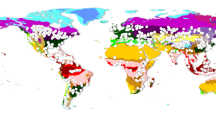Abstract
To abate the severe acidification of Swedish lakes are about 7% directly limed (AL-lakes). These are important to include when assessing acidification. Consequently, we need to estimate their chemical status as if they were not lime-affected. We hypothesize that there is a spatial dependence for calcium (Ca) and magnesium (Mg) concentrations. Spatial variation is determined using variograms. We study lakes within two 150 ∗ 150 km quadrates (EMEP150-grid) in the middle and southern parts of Sweden. We model Ca in AL-lakes using the Ca and Mg concentrations in nearby, unaffected lakes (UL-lakes). The mean Ca/Mg for the three or seven closest UL-lakes is used. We assume that Ca/Mg is constant for UL-lakes and that Mg unaltered by liming. For UL-lakes, Ca and Mg are spatially dependent. For AL-lakes, there is a spatial dependence for Mg, but, as anticipated, not for Ca. The modeled Ca for UL-lakes show a good correspondence with measured Ca; r 2 > 0.6; slopes close to 1 and intercepts almost 0. Using three or seven nearby lakes when modeling Ca give similar results. Modeled Ca was higher than measured Ca for 36% (three closest lakes) and 38% (seven closest) of the modeled AL-lakes in the middle part of Sweden. The corresponding results for the southern part were 10% and 9%, respectively. This model is an acceptable estimator of Ca in limed lakes and for estimating critical loads and acidification status on an EMEP-scale.
Similar content being viewed by others
References
Bellehumeur, C., Marcotte, D. and Legendre, P.: 2000, ‘Estimation of regionalized phenomena by geostatistical methods: Lake acidity on the Canadian Shield’, Environ. Geol. 39(3–4), 211–220.
Bringmark, E. and Bringmark, L.: 1995, ‘Disappearance of spatial variability and structure in forest floors – a distinct effect of air pollution?’, Water Air Soil Poll. 85, 761–766.
Bringmark, E. and Bringmark, L.: 1998, ‘Improved soil monitoring by use of spatial patterns’, Ambio 27, 45–52.
EMEP: 1998, Estimated Dispersion of Acidifying and Eutrophying Compounds and Comparisons with Observations, Transboundary Acidifying Air Pollution in Europe, Part 1, Status Report 1998, EMEP/MSC-W.
Fredén, C.: 1994, Geology, Swedish National Atlas, ISBN 91 87760 28 2.
Goovaerts, P.: 1998a, ‘Geostatistics in soil science: State-of-the-art and perspectives’, Geoderma 1401, 1–45.
Goovaerts, P.: 1998b, ‘Geostatistical tools for characterizing the spatial variability of microbiological and physico-chemical soil properties’, Biol. Fert. Soils 27, 315–334.
Gorham, E.: 1961, ‘Factors influencing supply of major ions to inland waters, with special reference to the atmosphere’, Geological Society of America Bulletin, 72, 795–840.
Henriksen, A., Kämäri, J., Posch, M., Lövblad, G., Forsius, M. and Wilander, A.: 1990, ‘Critical loads to surface waters in Fennoscandia. Intra- and inter-grid variability of critical loads and their exceedance’, Environmental Report Nord 1990:17, Nordic Council of Ministers, Copenhagen, Denmark.
Henriksen, A., Wilander, A., Kämäri, J., Posch, M., Forsius, M., Baxendale, H. and Tarvainen, T.: 1994, ‘Critical loads for acidification of surface waters in Northern Fennoscandia’, Report 33, Nordkalottkommiteens publikasjonsserie. ISSN 0348-8608, Norwegian Institute for Water Research, Oslo.
Henriksen, A., Skjelkvâle, B. L., Lien, L., Traaen, T. S., Mannio, J., Forsius, M., Kämäri, J., Mäkinen, I., Berntell, A., Wiederholm, T., Wilander, A., Moiseenko, T., Lozovik, P., Filatov, N., Niiniokja, R., Harriman, R. and Jensen, J. P.: 1996, ‘Regional lake surveys in Finland – Norway – Sweden – Northern Kola – Russian Karelia – Scotland – Wales 1995. Coordination and design’, NIVA Report 40/1996.
Isaaks, E.H. and Srivastava, R.M.: 1989, An Introduction to Applied Geostatistics. Oxford University Press, New York, Oxford.
Laberge, C., Cluis, D., Mallory, M. L. and McNicol, D. K.: 2000, ‘Rationalization of a regional network designed for trend detection of lake water quality in presence of spatial correlation’, Environmetrics 12, 41–56.
MarkInfo-homepage, Department of Forest Soils, Swedish University of Agricultural Sciences. http://www-markinfo.slu.se/sve/kem/vittring.html; 24-Jan-2003.
Matheron, G.: 1971, The Theory of Regionalized Variables and its Applications, Cahiers de Centre de Morphologie Mathematique de Fontainebleau no 5.
Oliver, M. A. and Webster, R.: 1991, ‘How geostatistics can help you’, Soil Use Manage. 7, 206–217.
Rapp, L.: 2001, ‘Critical Loads for Acid Deposition for Surface Water. Exploring Existing Models and a Potential Alternative for Sweden’, Silvestria 207, Department of Environmental Assessment, Swedish University of Agricultural Sciences, Uppsala, Sweden (Doctoral thesis).
Posch, M., de Smet, P. A. M., Hettelingh, J. P. and Downing, R. J.: 2001, ‘Modelling and mapping of critical thresholds in Europe: Status report 2001’, Coordination Center for Effects, RIVM Report No. 259101010, ISBN No. 96-9690-092-7, Bilthoven, The Netherlands.
Robertson, G. P.: 2000, GS+: Geostatistics for the Environmental Sciences, Gamma Design Software, Plainwell, Michigan, USA.
Rodhe, W.: 1949, ‘The ionic composition of lake waters’, Proceedings International Association of Theoretical and Applied Limnology 10, 377–386.
Swedish Environmental Protection Agency, Stockholm. Environmental Quality Objective. http:// www.internat.environ.se/index.php3?main = /documents/objectiv /objectiv.htm; accessed 24-Jan-2003.
United Nations Economic Commission for Europe, New York and Geneva, 106 pp.
Umweltbundesamt: 1996, ‘Manual and methodologies and criteria for mapping critical loads/levels’, (Mapping Manual). Texte 71/96. Berlin, UBA.
Webster, R.: 2001, ‘Statistics to support soil research and their presentation’, Eur. J. Soil Sci. 52(2), 331–340.
Webster, R. A and Oliver, M. A.: 1990, Statistical Methods in Soil and Land Resource Survey, Oxford University Press, New York, Oxford.
Webster, R. and Oliver, M. A.: 1992, ‘Sample adequately to estimate variograms of soil properties’, J. Soil Sci. 43, 177–192.
Wilander, A., Johnson, R. K., Goedkoop, W. and Lundin, L.: 1998, ‘Riksinventering 1995. En synoptisk studie av vattenkemi och bottenfauna i svenska sjöar och vattendrag’, Report 4813, Swedish Environmental Protection Agency, Stockholm. (In Swedish with English summary).
Wilander, A., Johnson, R. K. and Goedkoop, W.: 2003, ‘Riksinventering 2000’, Report 2003:1, Department of Environmental Assessment, Swedish University of Agricultural Sciences, Uppsala, Sweden (In Swedish with English summary).
Author information
Authors and Affiliations
Corresponding author
Rights and permissions
About this article
Cite this article
Göransson, E., Bringmark, E., Rapp, L. et al. Modeling the Effect of Liming on Calcium Concentration in Swedish Lakes. Environ Monit Assess 119, 331–348 (2006). https://doi.org/10.1007/s10661-005-9029-0
Received:
Accepted:
Published:
Issue Date:
DOI: https://doi.org/10.1007/s10661-005-9029-0




